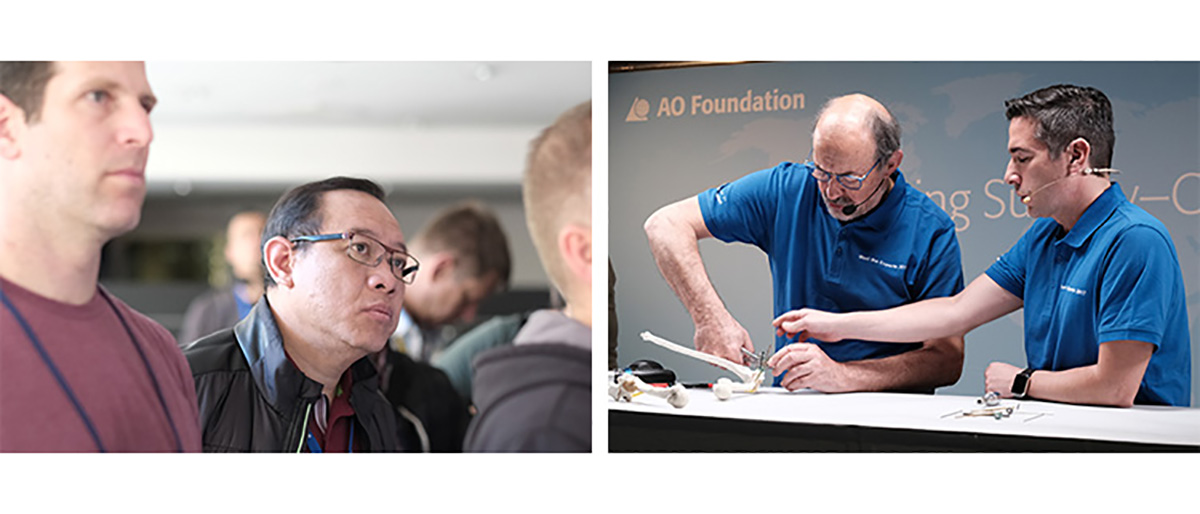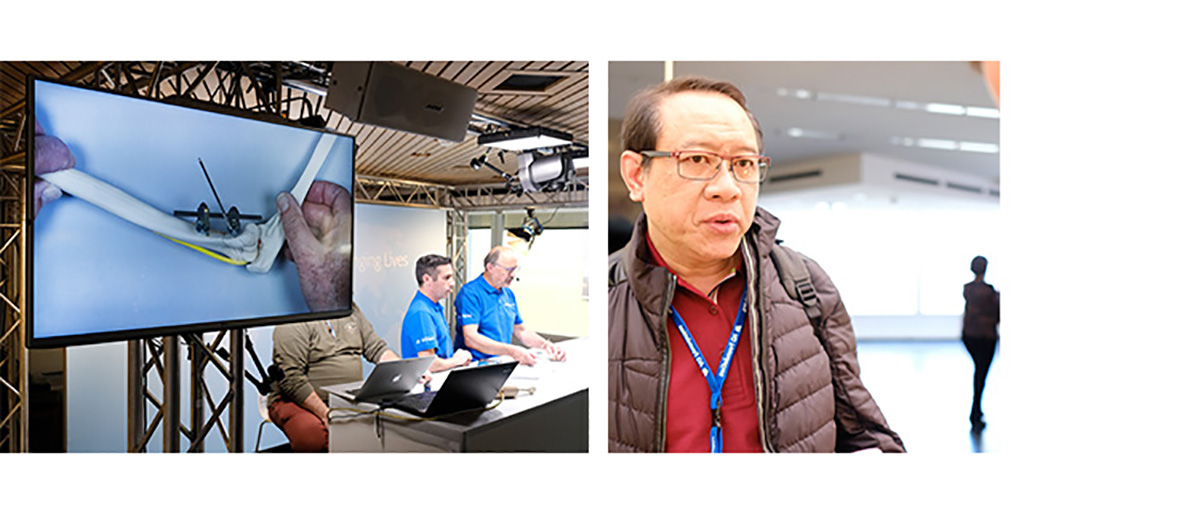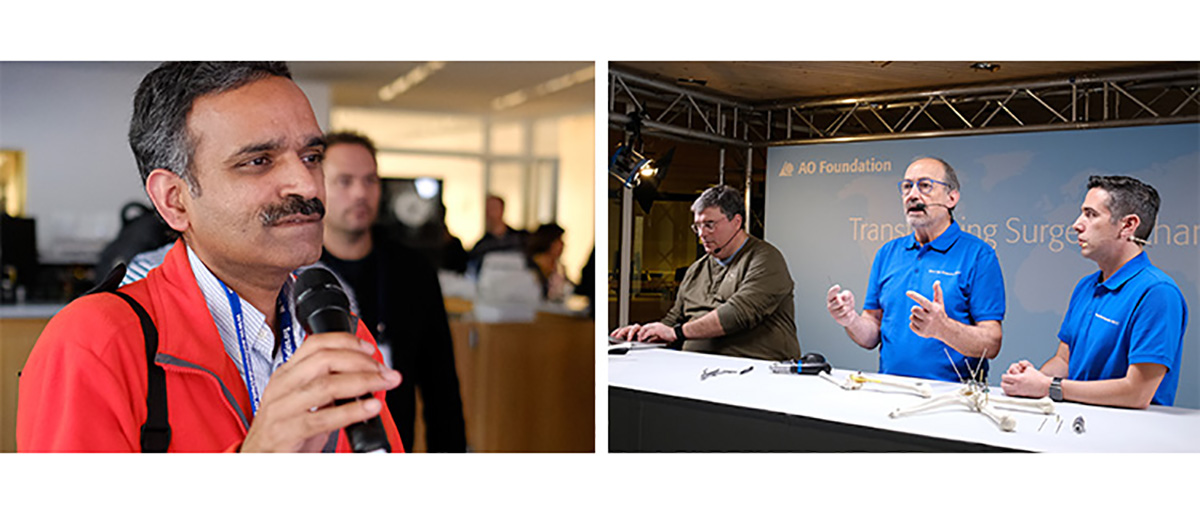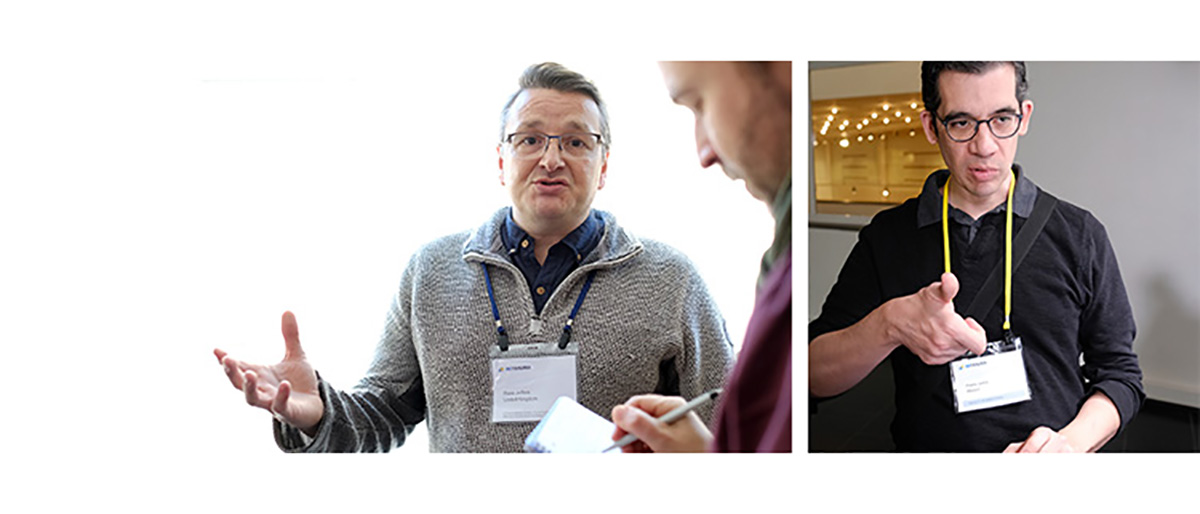Innovation on the menu at Cafe Chamonix
AO Technical Commission Meet the Experts

At a small café inside the Congress Center Davos, experts from the AO Technical Commission are cooking up some innovative new surgical techniques with an immediate, real-world impact.
Welcome to the AO Technical Commission Meet the Experts sessions, a series of interactive lunchtime seminars at the Davos Courses that provide access to cutting-edge technology and applied techniques in the world of orthopedic and trauma surgery.
Café Chamonix was overflowing with course attendees on the first Wednesday session, which was devoted to a simple yet chronically underused technique in treating complex elbow fractures in children.
Taking to the stage to demonstrate how to apply the small external fixator to the fractured joint were renowned trauma surgeons Theddy Slongo, Matias Sepulveda and Jon Dwyer, members of the AO Technical Commission
Welcome to the AO Technical Commission Meet the Experts sessions, a series of interactive lunchtime seminars at the Davos Courses that provide access to cutting-edge technology and applied techniques in the world of orthopedic and trauma surgery.
Café Chamonix was overflowing with course attendees on the first Wednesday session, which was devoted to a simple yet chronically underused technique in treating complex elbow fractures in children.
Taking to the stage to demonstrate how to apply the small external fixator to the fractured joint were renowned trauma surgeons Theddy Slongo, Matias Sepulveda and Jon Dwyer, members of the AO Technical Commission
The 45-minute talk, broadcast worldwide as a webinar for AO members, walked surgeons through the 10-minute procedure step by step, after which questions were taken from the live audience and over the internet.
“This fracture is one of the most challenging fractures in kids," said Theddy Slongo, opening the session. "We can show you how to fix it with very few problems."
The AO Technical Commission chose the topic because of its huge prevalence: Fixing supracondylar fractures of the humerus is the most commonly performed invasive pediatric surgery, with trampoline and bicycle accidents cited as among the most frequent culprits.
At stake is the quality of thousands upon thousands of young lives: By adopting this minimally invasive technique, which circumvents the need for Kirschner wires and the associated muscle-tearing surgery, doctors are potentially able to cut the average frequency of complications from one in three to one in a hundred.
"I'm really astonished that we accept more than 30% complications as surgeons," Slongo added. "We shouldn't accept any rate over 1-2%."
The issue is 40 times more prevalent in children than adults due to the nature of the joint's development, meaning that when a fracture occurs, the line of the break is commonly a zigzag rather than a straight line.
With the external fixator, which requires drilling two or three pins into the bones and attaching a couple of clamps, there is no need for a traditional plaster cast, minimizing the swelling and optimizing the movement and blood flow.
“This is a new technique with existing tools. We don’t have to invent something new,” Slongo said.
“This fracture is one of the most challenging fractures in kids," said Theddy Slongo, opening the session. "We can show you how to fix it with very few problems."
The AO Technical Commission chose the topic because of its huge prevalence: Fixing supracondylar fractures of the humerus is the most commonly performed invasive pediatric surgery, with trampoline and bicycle accidents cited as among the most frequent culprits.
At stake is the quality of thousands upon thousands of young lives: By adopting this minimally invasive technique, which circumvents the need for Kirschner wires and the associated muscle-tearing surgery, doctors are potentially able to cut the average frequency of complications from one in three to one in a hundred.
"I'm really astonished that we accept more than 30% complications as surgeons," Slongo added. "We shouldn't accept any rate over 1-2%."
The issue is 40 times more prevalent in children than adults due to the nature of the joint's development, meaning that when a fracture occurs, the line of the break is commonly a zigzag rather than a straight line.
With the external fixator, which requires drilling two or three pins into the bones and attaching a couple of clamps, there is no need for a traditional plaster cast, minimizing the swelling and optimizing the movement and blood flow.
“This is a new technique with existing tools. We don’t have to invent something new,” Slongo said.
The audience at the session was a mix of surgeons experienced in the technique, which is just a few years old, and total newcomers.
Hendradi Khumarga, a trauma surgeon who flew in from the Siloam clinic in Jakarta, hadn't previously been initiated in the application of the external fixator, and couldn't put a price on the knowledge he obtained at the session.
"I treat a lot of children," he said. "By using this kind of technique I will improve the quality of the surgery that I can offer to countless children."
At the other end of the spectrum, Pedro Jorba from the Legaria Children's Hospital in Mexico City, performs 50 or more of these kinds of operations a year.
"It's always extremely useful to get the opinions of these surgeons," he said, pointing to the panel. "These seminars are always so results-oriented. They're super useful."
Hendradi Khumarga, a trauma surgeon who flew in from the Siloam clinic in Jakarta, hadn't previously been initiated in the application of the external fixator, and couldn't put a price on the knowledge he obtained at the session.
"I treat a lot of children," he said. "By using this kind of technique I will improve the quality of the surgery that I can offer to countless children."
At the other end of the spectrum, Pedro Jorba from the Legaria Children's Hospital in Mexico City, performs 50 or more of these kinds of operations a year.
"It's always extremely useful to get the opinions of these surgeons," he said, pointing to the panel. "These seminars are always so results-oriented. They're super useful."
The AO Technical Commission is an engine of innovation within the AO Foundation, constantly developing and approving state-of-the-art surgical hardware and techniques to improve patient outcomes.
Created in 1961 by Maurice Muller and Robert Mathys, the AO Technical Commission is today composed of 120 member surgeons across 19 specialty areas, focusing on the fields of trauma, spine, CMF, neurosurgery and veterinary surgery.
In 2011, the AO Technical Commission initiated its Meet the Experts sessions as a means of sharing knowledge and raising awareness of the innovative techniques that have stemmed from this creative group of orthopedic surgeons.
Created in 1961 by Maurice Muller and Robert Mathys, the AO Technical Commission is today composed of 120 member surgeons across 19 specialty areas, focusing on the fields of trauma, spine, CMF, neurosurgery and veterinary surgery.
In 2011, the AO Technical Commission initiated its Meet the Experts sessions as a means of sharing knowledge and raising awareness of the innovative techniques that have stemmed from this creative group of orthopedic surgeons.




